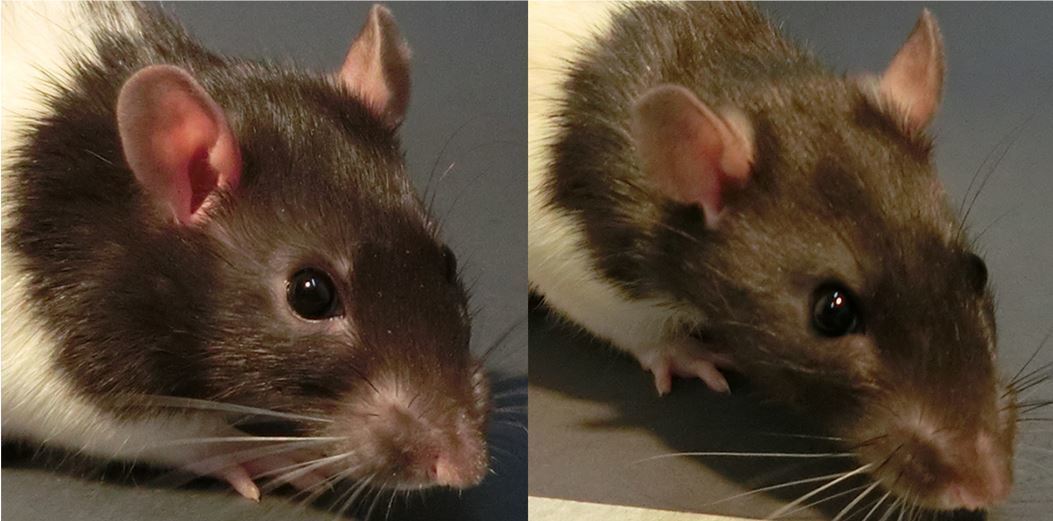
Researchers found that rats experiencing positive emotions had an increased pinkish hue on their ears, like the animal on the left. The animal on the right is from the control group. PLOS ONE hide caption

Researchers found that rats experiencing positive emotions had an increased pinkish hue on their ears, like the animal on the left. The animal on the right is from the control group.
PLOS ONEWondering if your pet rat is feeling happy? You should check its ears, researchers say.
A team of scientists in Switzerland found that a rat's ears are more pinkish and are positioned at a more relaxed angle when it is experiencing positive emotions. The researchers recently published their findings in the journal PLOS ONE.
Previous studies have focused on negative emotions –- for example, identifying how rats indicate that they are feeling pain, with the aim of learning how to avoid those situations.
Now, the research team led by Kathryn Finlayson is focused on promoting positive emotions in rats – rather than simply aiming for the absence of a negative state. As animal behavior researcher Luca Melotti tells The Two-Way, this is centered on the question of "what does it mean to have a life worth living?"

Shots - Health __news
Brain Scientists Trace Rat Ticklishness To Play Behavior
The researchers induced positive emotions in rats in order to observe how their facial expression changes — by tickling them. Previous research had established that rats enjoy being tickled –- which Melotti describes as "play" between rats and humans.
But there is some variety in how much individual rats enjoy being tickled. Some like it less than others, and some enjoy playing with other rats more than playing with humans. They indicate how happy they are through ultrasonic vocalizations that Melotti says are very strongly linked to positive feelings, and by returning to the experimenter's hands for more tickling.
"As we used tickling as a treatment, we had to focus on selecting those animals that were really ticklish and that really liked it," Melotti explains. The researchers selected the 15 male Lister Hooded rats that responded most positively to tickling from a larger pool of 75 rats.
They then recorded their facial expressions by tickling each rat, setting it down and immediately photographing it. As a control, they brought the animals to an unfamiliar room and projected bursts of mildly off-putting white noise, then likewise taking photos of the animals.
"In a positive situation the ears were more relaxed, because the ear angle was wider so they were more loose on the sides," Melotti says. "And also they were pinker, so the color was scored as a more vivid pink."

Rats experiencing positive emotions showed a more "relaxed" ear angle, such as the one on the left, compared to the control group, such as the rat on the right. PLOS ONE hide caption
Scientists have not yet pinpointed what a rat is feeling when it is experiencing a "positive" emotion. As Melotti explains, they are currently at the point where they can distinguish "positive" emotions from "negative" – but not finer emotional graduations between happiness, joy and optimism, for example.
It's interesting that rats show emotions on their faces because they are not particularly visual creatures, Melotti says. They're nocturnal and rely primarily on their sense of smell and touch.
The team says their findings could indicate that rats "may at least partly sense ... the facial expressions of their partner, along with other body postures, to gather information on the likelihood the partner will initiate play, and how intense that play is likely to be."
And knowing when a rat is feeling positive emotions also has numerous potential applications for human researchers, especially because rats are used in many different kinds of studies. Melotti says one possibility is developing an automated system that determines if a rat is in pain or feeling positive, which could be measured over time and used to improve the quality of life for the animals.
Their findings could also have implications for legislation, he says. "Not all regulations in every country are considering animals, especially lab animals, as sentient beings," he says. "So showing that ... a wide range of emotions are measurable in those animals is very important."
No comments:
Post a Comment